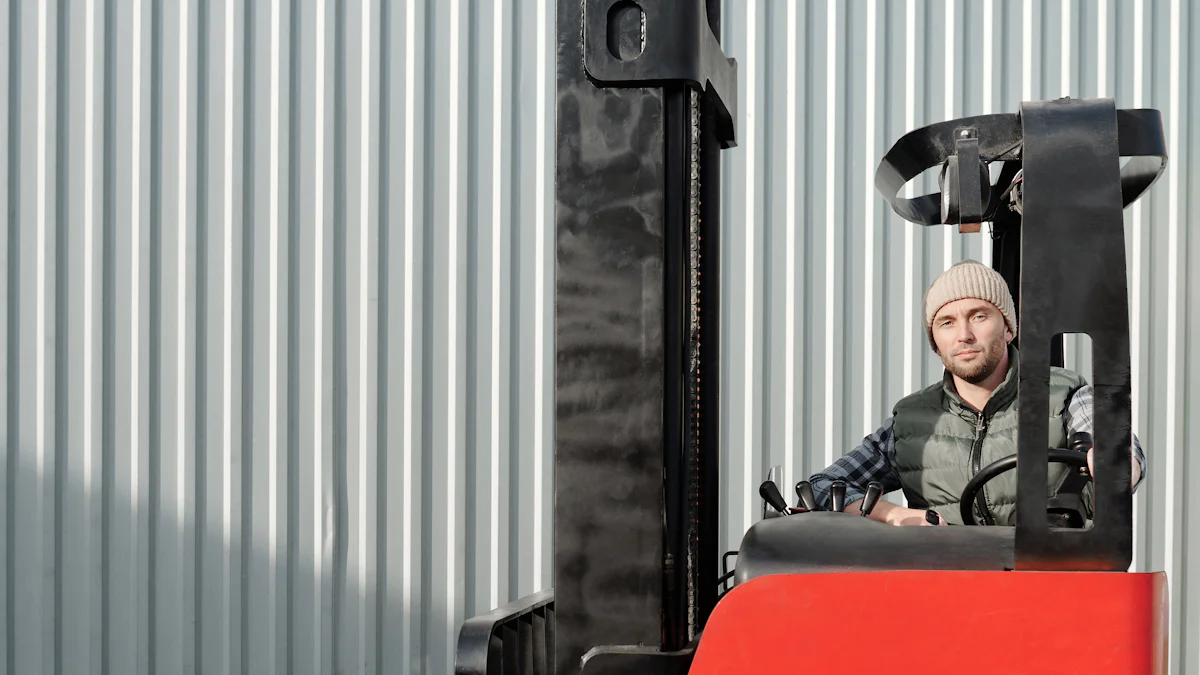When it comes to electric pallet jacks, safety is paramount. Understanding the significance of proper handling and operational care is crucial to prevent accidents. In this blog, we delve into the world of pallet jacks, emphasizing the importance of safe practices and efficient operation. By following the structured guidance provided, you will gain valuable insights into using electric pallet jacks responsibly and effectively.
Understanding the Electric Pallet Jack

Components and Controls
Main body and forks
An electric pallet jack consists of a sturdy main body that houses the essential components for operation. The forks, which are crucial for lifting and moving loads, are attached to the front of the jack. These forks provide stability and support when transporting pallets within warehouses or storage facilities.
Control handle and buttons
The control handle of an electric pallet jack serves as the primary interface for operators to maneuver the equipment effectively. By gripping the handle firmly, operators can navigate the jack with precision. Various buttons on the handle allow for seamless control over functions such as lifting, lowering, and steering.
Battery and charging system
Powering the operations of an electric pallet jack is its rechargeable battery system. This system ensures continuous functionality during work hours, providing sufficient energy to operate all components efficiently. Regular charging is essential to maintain optimal performance and avoid interruptions during tasks.
Safety Features
Emergency stop button
A critical safety feature of an electric pallet jack is the emergency stop button located prominently on the control panel. In case of unforeseen circumstances or hazards, pressing this button immediately halts all movement, preventing accidents and ensuring operator safety.
Safety guards and sensors
To enhance workplace safety, electric pallet jacks are equipped with safety guards and sensors that detect obstacles or obstructions in their path. These features help prevent collisions and injuries by alerting operators to potential dangers in their surroundings.
Load capacity indicators
Load capacity indicators on an electric pallet jack provide vital information regarding weight limits and safe loading practices. Operators must adhere to these indicators to prevent overloading, which can lead to equipment malfunction or accidents.
Preparatory Steps
Pre-Operational Checks
Inspecting the pallet jack
- Examine the electric pallet jack thoroughly to ensure all components are in proper working condition.
- Check for any visible damages or irregularities that may affect its performance.
- Verify that the wheels are intact and free of obstructions to guarantee smooth movement.
Checking the battery level
- Assess the battery status by checking the charge indicator on the control panel.
- Ensure that the battery is adequately charged to prevent interruptions during operation.
- Plan ahead and have a backup battery ready in case of low power to maintain workflow efficiency.
Ensuring the work area is clear
- Survey the surrounding environment to identify any potential hazards or obstacles.
- Clear pathways and remove any debris that could impede the movement of the electric pallet jack.
- Keep an eye out for slippery surfaces or uneven terrain that may pose risks while maneuvering the equipment.
Personal Safety Measures
Wearing appropriate PPE
- Put on safety gear such as a helmet, gloves, and steel-toed boots before operating the electric pallet jack.
- Ensure that your attire allows for ease of movement and does not obstruct your vision or handling of the equipment.
- Prioritize personal protective equipment to safeguard yourself from workplace accidents.
Understanding load limits
- Familiarize yourself with the weight capacity specifications of the electric pallet jack.
- Avoid exceeding the designated load limits to prevent strain on the equipment and maintain operational safety.
- Consult weight charts if necessary to determine suitable loads for transport based on capacity guidelines.
Familiarizing with the environment
- Acquaint yourself with the layout of your work area to anticipate navigation challenges.
- Identify emergency exits, fire extinguisher locations, and first aid stations for quick access during emergencies.
- Stay alert and attentive to your surroundings at all times to react promptly to changing conditions or unforeseen events within your workspace.
By following these preparatory steps diligently, you set a solid foundation for safe and efficient operation of electric pallet jacks in diverse workplace settings, aligning with industry standards for responsible equipment handling practices.
Operating the Electric Pallet Jack

Starting the Pallet Jack
Turning on the power
- Activate the electric pallet jack by locating the power switch.
- Switch it on securely to initiate the operational functions of the equipment.
- Ensure that the power indicator confirms successful activation.
Engaging the control handle
- Grasp the control handle firmly to prepare for maneuvering.
- Position your hand comfortably on the handle for optimal control.
- Verify that the handle responds smoothly to your touch.
Moving and Steering
Forward and reverse movement
- Initiate forward motion by gently twisting the controller in one direction.
- Control the speed with precision to navigate effectively within your workspace.
- Reverse movement is achieved by twisting the controller in the opposite direction.
Steering techniques
- Guide the electric pallet jack using subtle movements of the control handle.
- Adjust your steering technique based on obstacles or tight corners for seamless navigation.
- Practice gradual turns to enhance your proficiency in steering accurately.
Navigating tight spaces
- Approach confined areas cautiously, ensuring adequate clearance for safe passage.
- Maneuver with precision, utilizing small adjustments to avoid collisions or disruptions.
- Navigate through narrow spaces confidently, maintaining control over speed and direction.
Lifting and Lowering Loads
Positioning the forks
- Align the forks accurately beneath the pallet you intend to lift.
- Ensure proper placement for secure engagement with the load.
- Double-check alignment before initiating any lifting operations.
Lifting the load
- Elevate loads carefully by activating the lifting mechanism as needed.
- Monitor load balance during elevation to prevent shifting or instability.
- Confirm secure lifting before proceeding with transporting tasks.
Lowering the load safely
- Gradually lower loads by releasing pressure on the lifting controls gently.
- Maintain control, ensuring a smooth descent without sudden movements or drops.
- Verify completion, confirming that all loads are safely deposited before disengaging from lifting operations.
Best Practices and Safety Tips
Do’s and Don’ts
Do’s for Safe Operation
- Prioritize wearing safety gear to protect yourself during operation.
- Conduct regular maintenance checks on the electric pallet jack for optimal performance.
- Always follow designated pathways to avoid collisions and ensure a smooth workflow.
- Communicate effectively with colleagues to coordinate movements in shared workspaces.
Don’ts to Avoid Accidents
- Avoid overloading the pallet jack beyond its weight capacity to prevent equipment strain.
- Refrain from ignoring warning signals or alarms that indicate potential hazards.
- Never leave the pallet jack unattended while it is powered on to prevent unauthorized use.
- Do not engage in reckless maneuvers or high-speed operations that compromise safety measures.
Handling Different Load Types
Balanced Loads
- When transporting balanced loads, ensure they are evenly distributed on the forks for stability.
- Utilize proper securing techniques such as straps or wraps to prevent load shifting during transit.
Unbalanced Loads
- For unbalanced loads, exercise caution and adjust your handling technique accordingly.
- Slow down your movements and maintain a steady pace to counterbalance any uneven weight distribution.
Fragile Items
- Handle fragile items with care by reducing speed and avoiding sudden stops or sharp turns.
- Use additional padding or support structures when moving delicate materials to prevent damage.
Basic common sense procedures and expectations are all that’s needed to mitigate most pallet jack injury risks.
Troubleshooting Common Issues
Battery Problems
Low battery
- Check the battery indicator to monitor the charge level regularly.
- Plan for timely recharging to avoid interruptions during operation.
- Prepare a backup battery as a precautionary measure for continuous workflow.
Charging issues
- Inspect the charging connection for any loose cables or faulty connections.
- Reset the charger and ensure a secure link to the electric pallet jack.
- Verify that the charging process initiates correctly to maintain operational efficiency.
Mechanical Issues
Forks not lifting
- Assess the fork alignment beneath the load to confirm proper positioning.
- Adjust the fork placement if necessary to engage with the load securely.
- Test the lifting mechanism after adjustments to verify functionality.
Control handle malfunctions
- Restart the electric pallet jack to reset any control handle malfunctions.
- Calibrate the control settings to ensure responsiveness and accuracy.
- Contact maintenance personnel for further assistance if issues persist.
- To ensure safe and efficient operation of electric pallet jacks, prioritize proper training and adherence to safety practices.
- Following basic common sense procedures can significantly reduce the risk of injuries and equipment malfunctions.
- Remember, safety is paramount; practice caution, maintain your equipment diligently, and seek additional training if necessary.
Post time: Jun-21-2024
